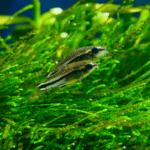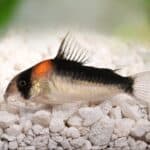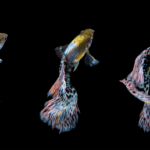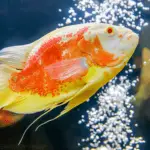Cory catfish are popular freshwater aquarium fish that are native to South America. They are peaceful, bottom-dwellers that rarely grow larger than a few inches. Cory catfish are also known as “Corydoras” or “Armored Catfish”.
A common question new fishkeepers have is “How often do Cory Catfish lay eggs?”
Cory Catfish are known to lay eggs every 7 days, but this number can vary depending on the individual fish. Corydoras can lay up to 10-20 eggs at a time. The eggs hatch in about 3-6 days and the fry are ready to be on their own in about 6 weeks. The eggs are usually laid on the glass of the aquarium and plants.
Breeding Corydoras is not difficult, but it does require some planning and patience. In this article, I’ll explain how to encourage Cory Catfish to breed and keep their eggs safe until they hatch.
How To Know if Cory Catfish Eggs are Fertilized
If you’re wondering whether or not your Cory Catfish eggs are fertilized, there are a few things you can look for:
For starters, fertilized eggs are usually a beige color with dark spots. infertile eggs, on the other hand, are typically white and semi-transparent.
Another way to tell if cory catfish eggs are fertilized is to look for embryos. You can do this by gently tipping the egg sac upside down onto a white surface. If you see small black dots, those are the embryos and the eggs are fertilized.
If you’re still not sure, you can try gently tapping the egg with a toothpick or other sharp object. If the egg is fertilized, the inner cell will be firm and won’t collapse. If the egg is infertile, the inner cell will collapse and the egg will be crushed.
How Long Do Cory Catfish Eggs Take to Hatch
Cory Catfish eggs generally take between 3 to 6 days to hatch, though this can vary somewhat depending on the specific species and environmental conditions. The eggs are typically laid in a pit or depression in the substrate, where they are then guarded by one or both parents. Once they hatch, the fry will remain close to the surface of the water until they are large enough to venture down into the middle and lower levels of the tank.
If the eggs do not hatch within a week, it is possible that the eggs are sterile, they can be removed. However, it is also possible that the eggs simply have not yet hatched. Therefore, it is advisable to wait a bit longer before disposing of the eggs, just to be sure.
How To Safely Keep The Cory Catfish Eggs?
To ensure the safety of Corydoras eggs, it is important to keep them in an environment that is free of predators and other potential dangers. The best way to do this is to keep them in a separate tank or container that is well-ventilated and has a stable water temperature. It is also important to keep the eggs covered with a layer of sand or gravel to prevent them from drying out.
The safest way to transport Cory Catfish eggs to a new tank is by using an egg tumbler. This will ensure that the eggs are not damaged during transport and that they will hatch successfully.
An egg tumbler is a device used to turn fish eggs so that they develop evenly. The tumbler consists of a cylindrical chamber that is rotated about its axis. Fish eggs are placed in the chamber and water is added. The rotation of the chamber causes the eggs to tumble, which prevents them from sticking to the walls of the chamber and ensures that they develop evenly.
How to Encourage Cory Catfish to Breed?
Breeding Cory catfish is relatively easy, as they are prolific breeders. Though it does require a little bit of preparation. Here are a few tips on how to encourage your corydoras to breed:
While Cory catfish can technically breed at any time of year, the spring months offer the best conditions for raising fry (baby fish). The first step is to set up a breeding tank. This should be a separate tank from the main aquarium and filled with soft, acidic water.
The water temperature should be between 65-75 degrees Fahrenheit. You can use a thermometer to keep track of the water temperature.
To increase your chances of success, start with a group of young Corys that are about one year old and 2.5 inches in length.
Provide plenty of hiding places in the tank. Corys are shy fish, and they will feel more comfortable if they have plenty of places to hide. This will also help reduce stress levels in the fish, which is important for breeding.
In the wild, Cory Catfish mate during the rainy season when the water temperature decreases slightly. This natural decrease in temperature triggers the spawning process in these fish. In an aquarium setting, you can replicate this by slowly decreasing the water temperature over a period of time until it reaches 65 degrees Fahrenheit.
Corys are omnivorous and will eat a variety of foods, but live food such as worms, larvae, and insects are essential for their breeding success.
Frequently Asked Questions
How to know if your Cory Catfish is pregnant?
The easiest way to tell if your Cory Catfish is pregnant is by looking for a gravid spot. This is a small, dark patch on the underside of the fish near the vent, and it indicates that the female is carrying eggs.
How do I know if my corydoras are mating?
When corydoras are ready to mate, they will assume a T-shaped position and the female will begin to suck sperm from the male’s abdomen area. If you see your corydoras doing this, they are likely mating.
How big do Cory Catfish get?
Most Cory Catfish grow to be about 2.5 inches long, although some can grow up to 4 inches. Corydoras are a popular choice for aquariums because they are relatively small and peaceful fish.






